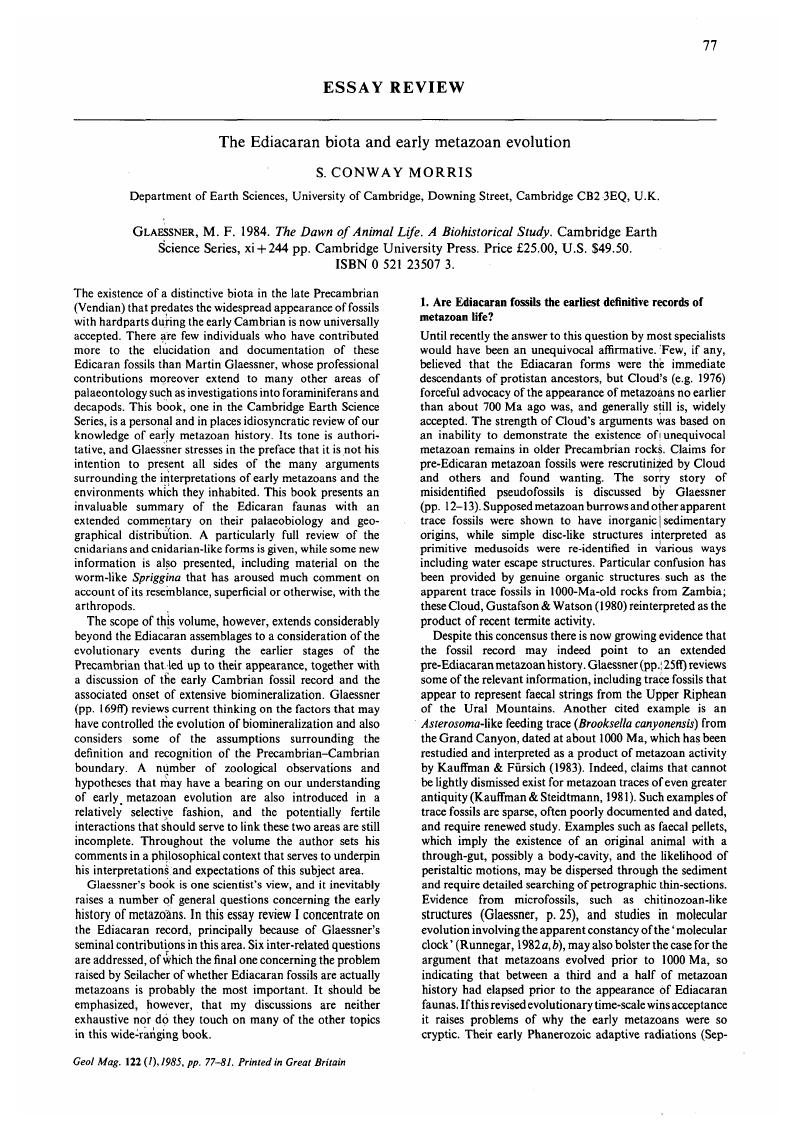Crossref Citations
This article has been cited by the following publications. This list is generated based on data provided by Crossref.
Gehling, J.G.
1987.
Earliest known echinoderm — a new Ediacaran fossil from the Pound Subgroup of South Australia.
Alcheringa: An Australasian Journal of Palaeontology,
Vol. 11,
Issue. 4,
p.
337.
Gehling, James G.
1988.
A cnidarian of actinian-grade from the Ediacaran Pound Subgroup, South Australia.
Alcheringa: An Australasian Journal of Palaeontology,
Vol. 12,
Issue. 4,
p.
299.
Morris, S. Conway
1989.
Burgess Shale Faunas and the Cambrian Explosion.
Science,
Vol. 246,
Issue. 4928,
p.
339.
Chakrabarti, A.
1990.
Traces and dubiotraces: examples from the so-called Late Proterozoic siliciclastic rocks of the Vindhyan Supergroup around Maihar, India.
Precambrian Research,
Vol. 47,
Issue. 1-2,
p.
141.
Bergström, Jan
1990.
Precambrian trace fossils and the rise of bilaterian animals.
Ichnos,
Vol. 1,
Issue. 1,
p.
3.
1990.
Typhloesus wellsi(Melton and Scott, 1973), a bizarre metazoan from the Carboniferous of Montana, U. S. A.
Philosophical Transactions of the Royal Society of London. B, Biological Sciences,
Vol. 327,
Issue. 1242,
p.
595.
Moczydłowska, Małgorzata
1991.
Acritarch biostratigraphy of the Lower Cambrian and the Precambrian-Cambrian boundary in southeastern Poland.
Vol. 29,
Issue. ,
p.
1.
Signor, Philip W.
and
Lipps, Jere H.
1992.
Origin and Early Evolution of the Metazoa.
Vol. 10,
Issue. ,
p.
3.
Jenkins, Richard J. F.
1992.
Origin and Early Evolution of the Metazoa.
Vol. 10,
Issue. ,
p.
131.
Farmer, J.
Vidal, G.
Moczydłowska, M.
Strauss, H.
Ahlberg, P.
and
Siedlecka, A.
1992.
Ediacaran fossils from the Innerelv Member (late Proterozoic) of the Tanafjorden area, northeastern Finnmark.
Geological Magazine,
Vol. 129,
Issue. 2,
p.
181.
Shu, Degan
2005.
On the Phylum Vetulicolia.
Chinese Science Bulletin,
Vol. 50,
Issue. 20,
p.
2342.
Liu, Alexander G.
Kenchington, Charlotte G.
and
Mitchell, Emily G.
2015.
Remarkable insights into the paleoecology of the Avalonian Ediacaran macrobiota.
Gondwana Research,
Vol. 27,
Issue. 4,
p.
1355.
Ansari, A.H.
Pandey, S.K.
Sharma, Mukund
Agrawal, Shailesh
and
Kumar, Yogesh
2018.
Carbon and oxygen isotope stratigraphy of the Ediacaran Bilara Group, Marwar Supergroup, India: Evidence for high amplitude carbon isotopic negative excursions.
Precambrian Research,
Vol. 308,
Issue. ,
p.
75.
Jackson, Togwell A.
2018.
Variations in the Properties of Extractable “Humic Matter” and Associated Kerogen in Sediments through Geologic Time: Their Significance for Precambrian Biological Evolution and Paleoecology.
Geomicrobiology Journal,
Vol. 35,
Issue. 4,
p.
334.



